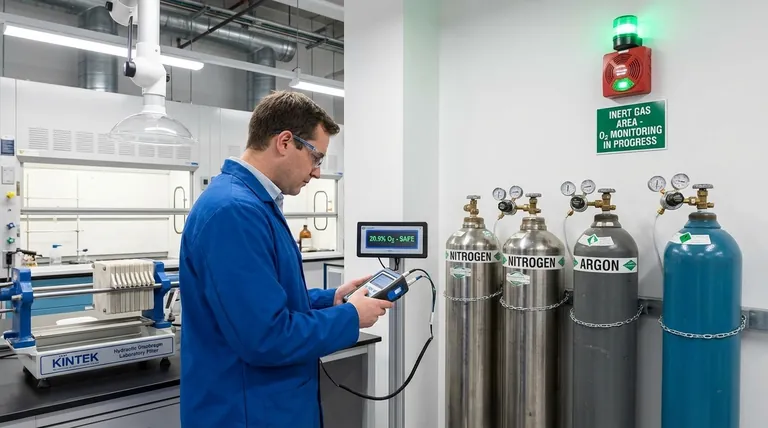Inert gases are not toxic or chemically reactive, but they are not inherently safe. Their primary danger comes from their ability to displace oxygen in the air, creating an environment that can cause rapid asphyxiation and death without any warning signs.
The core principle of inert gas safety is recognizing that the danger is not what the gas is, but what it displaces. Because they are colorless, odorless, and don't trigger the body's natural suffocation alarms, they pose a silent and severe risk in any poorly ventilated area.

The Hidden Danger: Understanding Asphyxiation
The primary hazard associated with inert gases like nitrogen, argon, helium, and carbon dioxide is their potential to create an oxygen-deficient atmosphere. This danger is particularly insidious because it is completely invisible to human senses.
How Inert Gases Affect the Body
Inert gases do not poison you; they simply dilute the concentration of oxygen in the air you breathe. When the oxygen level drops below the normal ~21%, your body is starved of what it needs to function.
Unconsciousness can occur in seconds, often with no preceding symptoms. A person can walk into an oxygen-deficient room and collapse without ever realizing they are in danger.
The Lack of Warning Signs
These gases are colorless and odorless. Unlike smoke or a chemical irritant, there is no smell, taste, or burning sensation to alert you that something is wrong. The environment can feel completely normal right up until the point of collapse.
Why the Body's Alarms Don't Sound
Crucially, the human body's primary trigger to breathe is the buildup of carbon dioxide (CO2) in the blood, not the lack of oxygen (O2).
In an atmosphere saturated with an inert gas, you can continue to exhale CO2. Because CO2 levels don't rise abnormally, your brain never receives the urgent signal that you are suffocating. There is no gasping for air or feeling of panic.
Key Factors That Determine Risk
The level of danger is not constant; it is dictated entirely by the environment and the volume of the gas being handled. Understanding these factors is critical for a proper risk assessment.
Enclosed or Poorly Ventilated Spaces
This is the single most important factor. In an open, outdoor area, a small inert gas leak will typically dissipate harmlessly. In a confined space—such as a small lab, a basement, a utility vault, or a tank—the gas can quickly accumulate and displace the breathable air.
The Volume of the Gas Release
A small, slow leak from a fitting poses a much lower risk than the catastrophic failure of a valve on a high-pressure cylinder. The total volume of gas released determines how quickly it can reduce the oxygen concentration in a given space to a dangerous level.
The Density of the Gas
Some inert gases have different densities than air, which affects where they accumulate. Argon, for example, is significantly heavier than air and will pool in low-lying areas like pits, trenches, and basements. Helium is much lighter and will rise, while Nitrogen has a density very similar to air and will mix more evenly.
Common Pitfalls and Misconceptions
Trusting your senses or intuition when working with inert gases can be a fatal mistake. Awareness of these common misconceptions is a critical layer of safety.
Assuming "Non-Toxic" Means "Safe"
This is the most dangerous misunderstanding. The "non-toxic" classification only refers to the gas's lack of chemical reactivity with the body. It does not account for the physical hazard of oxygen displacement, which is the actual threat.
The "I Can Just Leave" Fallacy
Many people believe they will feel dizzy or lightheaded and have time to escape. With significant oxygen displacement, loss of consciousness can happen in one or two breaths, leaving absolutely no time to react or self-rescue.
Attempting a Rescue Without Equipment
A common cause of multiple-fatality incidents is a would-be rescuer entering a confined space to help a collapsed colleague. Without a Self-Contained Breathing Apparatus (SCBA), the rescuer will almost certainly become the second victim within seconds.
How to Apply This to Your Project
Safe handling of inert gases is achieved through engineering controls, strict procedures, and unwavering awareness of the asphyxiation hazard.
- If your primary focus is working in any enclosed area: Always use a calibrated, personal oxygen monitor with an audible alarm set to alert you before the oxygen level reaches the danger zone (typically 19.5%).
- If your primary focus is facility design: Prioritize robust mechanical ventilation as the primary engineering control to ensure inert gases cannot accumulate to dangerous concentrations.
- If your primary focus is emergency response: Establish and enforce a strict policy that prohibits anyone from entering a suspected oxygen-deficient area to perform a rescue without proper training and SCBA equipment.
- If your primary focus is general handling: Ensure all compressed gas cylinders are properly secured, all fittings are leak-tested, and all personnel are trained on the specific hazards of asphyxiation.
Treating every inert gas as a potential asphyxiant is the fundamental principle for ensuring a safe working environment.
Summary Table:
| Hazard | Key Insight | Safety Measure |
|---|---|---|
| Asphyxiation | Displaces oxygen; colorless, odorless, and provides no warning. | Use a personal oxygen monitor with an audible alarm. |
| Confined Spaces | Gas accumulates rapidly, leading to unconsciousness in seconds. | Ensure robust mechanical ventilation in enclosed areas. |
| Rescue Attempts | Entering without equipment can make the rescuer a second victim. | Prohibit entry without a Self-Contained Breathing Apparatus (SCBA). |
Ensure your lab operates with the highest safety standards.
Handling inert gases requires specialized equipment and rigorous protocols to prevent asphyxiation risks. KINTEK specializes in providing reliable lab equipment and consumables, including gas handling systems and safety monitors, to protect your team and your research.
Don't compromise on safety. Contact our experts today to discuss your specific lab needs and how we can help you create a safer working environment.
Visual Guide

Related Products
- Hydraulic Diaphragm Lab Filter Press for Laboratory Filtration
- Automatic Laboratory Hydraulic Press for XRF & KBR Pellet Press
- Manual High Temperature Heated Hydraulic Press Machine with Heated Plates for Lab
- Single Punch Electric Tablet Press Machine Laboratory Powder Tablet Punching TDP Tablet Press
- Low-Temperature Water-Cooled Touchscreen Vibratory Ultrafine Pulverizer
People Also Ask
- What are the failures in a hydraulic system? Prevent Costly Downtime with Expert Diagnosis
- What are the factors that affect the filtration of the solution? Master the Key Variables for Optimal Performance
- What are some of the problems related to hydraulic power? Manage Leaks, Contamination, and Inefficiency
- What is the number one cause of failure in hydraulic systems? The Silent Killer of Your Equipment
- What are the most common causes of hydraulic system failure? Prevent Downtime and Costly Repairs



















